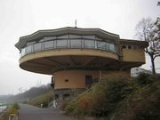
Wilhelm Riphahn
Encyclopedia
Wilhelm Riphahn was a German
architect
.
Riphahn studied at the technical universities in Berlin-Charlottenburg
, Munich
, and Karlsruhe
. He worked for a Siemens
construction office in Berlin and in 1912 for "Gebrüder Taut & Hoffmann". In 1913 Riphahn became an independent architect and worked with Caspar Maria Grod until 1931. Some of his more well-known works include the Bastei restaurant and the Cologne opera house.
Riphahn is buried in Cologne's Melaten cemetery.

Germany
Germany , officially the Federal Republic of Germany , is a federal parliamentary republic in Europe. The country consists of 16 states while the capital and largest city is Berlin. Germany covers an area of 357,021 km2 and has a largely temperate seasonal climate...
architect
Architect
An architect is a person trained in the planning, design and oversight of the construction of buildings. To practice architecture means to offer or render services in connection with the design and construction of a building, or group of buildings and the space within the site surrounding the...
.
Riphahn studied at the technical universities in Berlin-Charlottenburg
Charlottenburg
Charlottenburg is a locality of Berlin within the borough of Charlottenburg-Wilmersdorf, named after Queen consort Sophia Charlotte...
, Munich
Munich
Munich The city's motto is "" . Before 2006, it was "Weltstadt mit Herz" . Its native name, , is derived from the Old High German Munichen, meaning "by the monks' place". The city's name derives from the monks of the Benedictine order who founded the city; hence the monk depicted on the city's coat...
, and Karlsruhe
Karlsruhe
The City of Karlsruhe is a city in the southwest of Germany, in the state of Baden-Württemberg, located near the French-German border.Karlsruhe was founded in 1715 as Karlsruhe Palace, when Germany was a series of principalities and city states...
. He worked for a Siemens
Siemens AG
Siemens AG is a German multinational conglomerate company headquartered in Munich, Germany. It is the largest Europe-based electronics and electrical engineering company....
construction office in Berlin and in 1912 for "Gebrüder Taut & Hoffmann". In 1913 Riphahn became an independent architect and worked with Caspar Maria Grod until 1931. Some of his more well-known works include the Bastei restaurant and the Cologne opera house.
Riphahn is buried in Cologne's Melaten cemetery.

Literature
- Heinrich de Fries (Einl.): Wilhelm Riphahn. F. E. Hübsch, Berlin, Leipzig, Wien 1927.
- als Nachdruck: Gebr. Mann, Berlin 1996, ISBN 3-7861-1813-2. (mit einem Nachwort zur Neuausgabe von Wolfram Hagspiel)
- Wolfram Hagspiel: Der Kölner Architekt Wilhelm Riphahn. Sein Lebenswerk von 1913 bis 1945. König, Köln 1982, ISBN 3-88375-017-4. [Zugl.: Köln, Univ., Diss.: 1981.]
- Werner Mantz. Architekturphotographie in Köln 1926–1932. Ausstellungskatalog, Museum Ludwig Köln, Köln 1982.
- Clemens Klemmer: Der Kölner Architekt Wilhelm Riphahn (1889–1963). In: Werk, Bauen+Wohnen, 76. / 43. Jahrgang 1989, Heft 3, S. 72 und 74 (mit Literaturangaben).
- Wilhelm Riphahn, Architekt in Köln. Eine Bestandsaufnahme. [anlässlich der Ausstellung Wilhelm Riphahn – Architekt in Köln im Museum für Angewandte Kunst Köln vom 18. September 2004 bis 2. Februar 2005; Katalog] / hrsg. vom Museum für Angewandte Kunst Köln. Britta Funck. Mit Beiträgen von Gudrun Escher, Monika Läuferts und Texten von Wilhelm Riphahn. König, Köln 2004, ISBN 3-88375-881-7.

